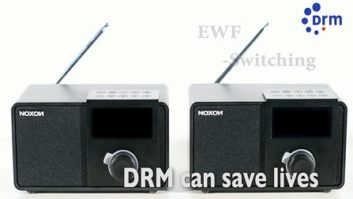In the March 1 issue, we talked about Category 5 and Category 5e.
Category 5e was formulated because of a new application for these premise/data cables: Gigabit Ethernet. Where regular old Ethernet used two pairs – one to transmit and one to receive – Gigabit Ethernet splits the signal into four parts and sends each part down a pair, so all four pairs are working simultaneously.
Not only that, but each pair is transmitting and receiving at the same time, called “duplex” transmission. Your telephone does duplex transmission, with one pair of wires carrying the conversation of both you and your caller. But Gigabit Ethernet carries high-speed data in both directions.
Because the data is compressed, it requires less bandwidth than the 250 MHz of an uncompressed data stream. 250 MHz times four pairs equals 1 GHz. But standard Category 5e is not tested or verified to 250 MHz. It is specified only to 100 MHz, like Category 5, so the data has to be compressed.
It’s not until we get to Category 6, with a bandwidth of 250 MHz, that we could, theoretically, run uncompressed Gigabit Ethernet.
Category 6
So we arrive at the emerging Cat-6.
As of this writing, the TIA/EIA 568 committee is on Draft 10a. How many drafts until they are finished? Well, it took until Draft 14 to finish work on Category 5e, so don’t hold your breath.
You can be sure the cable used for Category 5 would have a hard time carrying Gigabit Ethernet. There are many important parameters for Gigabit that were not even considered for Category 5. The accompanying table compares basic specifications of Category 5, 5e and the “emerging” Category 6.
Here are some quick definitions of the parameters listed in the table. Note that these are the minimum or maximum expected of any cable made to the standard. Some cables are better than the standard. A few are a lot better than the standard. Compare the manufacturers actual measured and verified data to the standard.
Attenuation: The basic signal loss in the cable. Of course there are many data points below 100 MHz (or 250 MHz). These numbers are the maximum attenuation any cable should show.
Power-Sum: This refers to the test procedure where the signal is applied to three of the pairs and the resultant measurement is read on the fourth pair. This is done for all pair combinations and the results are averaged.
Equal Level: This assures that the signals transmitted are all at the same level, which is critical particularly where all four pairs are used, such as in 1000baseT, Gigabit Ethernet.
Near-end Crosstalk: Also called NEXT, this shows the crosstalk at the signal source, the near-end, where the signal is strongest.
Far-end Crosstalk: Also called FEXT, this shows the crosstalk at the signal destination, where the signal is weakest. The number shown is the minimum value in any cable.
Attenuation-Crosstalk Ratio: Also called ACR, this is the data equivalent of signal-to-noise ratio. Positive ACR, especially at high frequencies, is a good thing. The number shown is the minimum to be expected.
Delay Skew: Timing difference between the four pairs. The timing measurement is in nanoseconds (billionths of a second), abbreviated as nsec. The number shown is the maximum allowed.
Return Loss: Loss caused by impedance variations in the cable. The larger the negative number, the better the cable (i.e. -20 dB return loss is better than -15 dB return loss). Not to be confused with Structural Return Loss, a much simpler and less accurate measurement.
Some manufacturers produce high- and low-quality cables within a certain specification. Most of them call such cables “low 5e” and “high 5e,” for instance.
Some might say 5e and 5e+. To say “5e enhanced” is confusing because it is redundant: “Enhanced Category 5 enhanced.” Still others are touting Category 6+ or “enhanced Category 6,” when there isn’t even a ratified standard for regular Category 6 yet. Give me a break!
There are manufacturers that make a “low 5e” that is close to other manufacturers’ “high 5e.”
So how do you tell the difference between data cables, without a degree in cable engineering? Read the numbers. Get the data. Get the measured, tested, third-party-verified cable performance, made to the 568 standard, and compare them.
And don’t just check the basic specs, like attenuation and crosstalk, but look at the minor specs such as pull strength or minimum bend radius. Sometimes these minor specs can speak volumes about the consistency and quality of a cable.
Things change
You can see from the table that, as we progress from Category 5, to 5e, to 6, the basic specifications get a bit tighter (and make a big jump in most cases to 6).
There also are some new added specifications in 5e such as “delay skew” and “return loss” that weren’t part of Category 5. These are specifications that required in the new standard for Gigabit applications.
If you ever play with RGB cables to run monitors, you would know “delay skew” as “timing” or “timing errors.” If you’re splitting up signals, as we do for Gigabit where the signal, then they have to arrive within a certain window at the other end. The maximum delay for 100 meters (328 feet) is 45 nanoseconds. Not so surprisingly, the maximum delay on RGB coaxes is 40 nsec before you exceed “broadcast quality.”
There are some 5e cables that do much better than 45 nsec. Some bonded-pair 5e cables are as low as 25 nsec. There are some Category 6 cables that are 10 nsec guaranteed, 7 nsec typical. This means these cables could run farther, or produce less time-related bit errors at the same distance as other cables.
Return loss will be recognized by many transmitter engineers as VSWR, for voltage standing wave ratio. While VSWR is a ratio, return loss is expressed in dB. But it’s the same phenomenon: impedance variations that cause signals, especially high-frequency signals, to reflect back to the source.
Category 5e and 6 both have return loss requirements. Those who understand VSWR will recognize these values as pretty timid numbers.
We’ll continue with our look at Category cables in our next episode.












